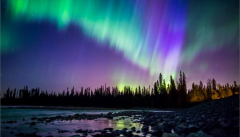
Science Journalism
From the Sun to our Earth, the birth of Northern lights
Have you ever seen these wonderful colourful lights in the sky ? Aurora borealis are an incredible phenomenon at the heart of many legends. We all know how they look like, but have you ever wondered how they came to be ?
First, we have to go back to the principle of light and colour. To make it simple, we see colour when a photon (light wave) hits and bounces off an object into our eyes after having taken its colour. Now you may wonder how we can see colours in the night sky when there is no light from the sun ?
These lights take their origin in the sun. Our star produces almost constantly solar winds, which send some energetically charged particles to the Earth. The collision between these particles and the particles of the atmosphere of the Earth is what, ultimately, forms Polar Lights.
Solar winds travels the solar system at incredibly high speeds (400 to 800 km/s). In this wind, we can find electrically charged particles such as electrons, protons and ions. The Earth is subjected to these winds and receives these particles. Their speed allows them to cross the magnetic barrier where it the thinnest, meaning at the poles of the magnetic field created by the Earth, which are, coincidentally, at the physical poles of the Earth.
What is this magnetic barrier we mentionned? Well, the Earth is surrounded by a magnetic field which acts as a shield outside the atmosphere. When the particles ejected by the sun come into contact with this shield, they will go around it, and some will try to slip into the atmosphere, using the path where the shield is the weakest, that is to say in the north and south poles of the magnetic field. These particles come into contact with atoms of the atmosphere (mainly nitrogen and oxygen) which receive the energy from the solar particles. They cannot contain this energy for long, for the ionised state is very unstable, so they release it in the form of light.
The colour produced depends on the atom which has received the energy and the amount of energy received. For example, an atom of oxygen will release mainly green light, and some red light, nitrogen emits blue, red and purple light. At the high altitudes where Northern Lights occur, there is more oxygen than nitrogen in the atmosphere, which explains the usual green color of this phenomenon.
Auroras happens all year long, but are only visible when the nights are dark enough. This is why travelling companies will advise you to go see them between September and March. The intensity of the lights is very fluctuacting from one year to another. It depends on the Sun’s activity and the magnitude of the solar winds. Even if the sun's activity is quite unpredictable, it follows a general eleven year cycle. The lights are only visible at certain latitudes, around the poles, but on some occasions where the winds are exceptionnally strong, they can be seen further South. In 1621, they have been observed in the South of France by the astronomer Pierre Gassendi, who coined the term “aurora borealis”.
Myths
The aurora borealis is at the heart of many legends. It is a phenomenon that always interested humans, from early Antiquity up to today.
Some Inuit tribes in Greenland believe that the lights are spirits playing with walrus skulls. Others saw them as the light from torches of spirits that guided other spirits on the path between heaven and the afterlife. In Finland, the legends talks about a mystical fox which ran through the sky, projecting dust into the sky with its tail. In the Algonquin tribe, these lights are the reflection of giant fires started by the maker of the Universe. They saw it as a comforting sign that the maker of all things still cared about its creations. In Europe and China, Northern lights participated in legends about dragons.
On other planets
Aurora borealis also occur on other planets than Earth. Scientists already observed this phenomenon on various planets such as Jupiter, Saturn or Venus. For the two first, the phenomenon can appear even with the strong magnetic fields of these planets. It is possible for Aurora borealis to be observed with space telescopes. But scientists also observed them on Venus which doesn't have any magnetic field. That's why it is possible to see them clearly, with a high intensity, everywhere on the planet.
Further in the galaxy, in 2015, scientists saw their first extra-solar aurora. It was brighter than the Earth’s ones, and of a red color.
You want to be sure that you understood everything ? Watch this video :



